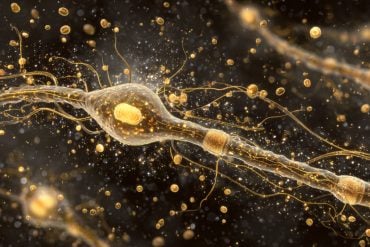Summary: Signatures of brain activity in infants can predict autism symptoms at 18 months of age. In infants who later received a diagnosis of ASD, researchers noted decreased connectivity between frontal brain regions. The infants also showed increased connectivity across temporoparietal areas in the right hemisphere, which were associated with social information processing.
Source: Elsevier
Autism spectrum disorder (ASD) is rarely diagnosed until symptoms arise, often well into childhood. Evidence however, is mounting that developmental abnormalities likely emerge in the brain long before then: early identification of babies at risk for ASD could allow for interventions that would improve their developmental outcomes.
Researchers at the University of California, Los Angeles, have found evidence of signature brain activity in infants that predicted ASD symptoms later at 18 months old. The work, led by Shafali Jeste, MD, at UCLA appears in Biological Psychiatry: Cognitive Neuroscience and Neuroimaging.
“Early identification and intervention is key to getting better outcomes for children with neurodevelopmental disorders,” said Cameron Carter, MD, Editor of Biological Psychiatry: Cognitive Neuroscience and Neuroimaging. “This study suggests that relatively low-cost diagnostic tools such as EEG may, in the not-too-distant future, help us to do a better job by identifying atypical brain development in infancy, when interventions may be even more impactful than when offered to toddlers and young children.”
The researchers used electroencephalography (EEG), a non-invasive technique to measure electrical brain activity from outside the head and tracked neural activity in the so-called alpha range. Alpha-range activity is associated with long-range connections in the brain. The group then used an approach that allowed them to integrate data from across the brain.
First author Abigail Dickinson, PhD, said, “One crucial aspect of brain development is the change in patterns of brain activity. We wanted to know if measures of neural activity could detect atypical brain development in ASD during early infancy.”
Dr. Dickinson and the team performed EEG measurements in 65 3-month-old infants; 29 with low familial risk of ASD and 36 at high risk, with an affected older sibling.
When the children were 18-months-old, they were assessed for ASD by a trained clinician.
The researchers used computer modeling to predict symptom outcomes at 18 months based on the babies’ neural activity in infancy. The model’s predictions correlated with the actual symptoms measured in the toddlers. The model was not able to predict verbal or non-verbal congitive scores in the toddlers–suggesting that the brain connectivity pattern may be a specific marker of ASD.

In infants that later showed higher ASD symptoms, researchers saw decreased connectivity between frontal regions. The infants also showed increased connections across temporo-parietal areas in the right hemisphere, which are associated with social information processing.
“These findings improve our understanding of the neural differences that precede autism and show which brain regions reveal the earliest signs of disruption,” Dr. Dickinson said. The findings bolster the idea that disrupted brain connectivity is a root cause of ASD, not a consequence.
The authors suggest that the low cost, wide availability and low risk of EEG make it a good screening tool to identify babies at higher risk of developing ASD or those with “borderline” symptoms, so that they get early intervention. “Mapping patterns of activity associated with autism could ultimately help identify infants who show early signs of neural risk,” Dr. Dickinson added.
About this autism research article
Source:
Elsevier
Contacts:
Rhiannon Bugno – Elsevier
Image Source:
The image is credited to Society of Biological Psychiatry, Elsevier.
Original Research: Closed access
“Multivariate neural connectivity patterns in early infancy predict later autism symptoms” by Abigail Dickinson, Manjari Daniel, Andrew Marin, Bilwaj Gaonkar, Mirella Dapretto, Nicole McDonald, Shafali Jeste. Biological Psychiatry: Cognitive Neuroscience and Neuroimaging.
Abstract
Multivariate neural connectivity patterns in early infancy predict later autism symptoms
Background
Functional brain connectivity is altered in children and adults with autism spectrum disorder (ASD). Functional disruption during infancy could provide earlier markers of ASD, thus providing a crucial opportunity to improve developmental outcomes. Using a whole-brain multivariate approach, we asked whether electroencephalography measures of neural connectivity at 3 months of age predict autism symptoms at 18 months.
Methods
Spontaneous electroencephalography data were collected from 65 infants with and without familial risk for ASD at 3 months of age. Neural connectivity patterns were quantified using phase coherence in the alpha range (6–12 Hz). Support vector regression analysis was used to predict ASD symptoms at age 18 months, with ASD symptoms quantified by the Toddler Module of the Autism Diagnostic Observation Schedule, Second Edition.
Results
Autism Diagnostic Observation Schedule scores predicted by support vector regression algorithms trained on 3-month electroencephalography data correlated highly with Autism Diagnostic Observation Schedule scores measured at 18 months (r = .76, p = .02, root-mean-square error = 2.38). Specifically, lower frontal connectivity and higher right temporoparietal connectivity at 3 months predicted higher ASD symptoms at 18 months. The support vector regression model did not predict cognitive abilities at 18 months (r = .15, p = .36), suggesting specificity of these brain patterns to ASD.
Conclusions
Using a data-driven, unbiased analytic approach, neural connectivity across frontal and temporoparietal regions at 3 months predicted ASD symptoms at 18 months. Identifying early neural differences that precede an ASD diagnosis could promote closer monitoring of infants who show signs of neural risk and provide a crucial opportunity to mediate outcomes through early intervention.






